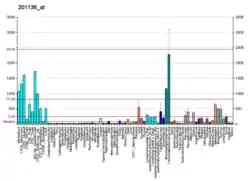PLP2
Proteolipid protein 2 is a protein that in humans is encoded by the PLP2 gene.[5][6][7]
References
- GRCh38: Ensembl release 89: ENSG00000102007 - Ensembl, May 2017
- GRCm38: Ensembl release 89: ENSMUSG00000031146 - Ensembl, May 2017
- "Human PubMed Reference:". National Center for Biotechnology Information, U.S. National Library of Medicine.
- "Mouse PubMed Reference:". National Center for Biotechnology Information, U.S. National Library of Medicine.
- Oliva MM, Wu TC, Yang VW (May 1993). "Isolation and characterization of a differentiation-dependent gene in the human colonic cell line HT29-18". Arch Biochem Biophys. 302 (1): 183–192. doi:10.1006/abbi.1993.1197. PMID 8470895.
- Oliva MM, Cortese JF, Yang VW (Aug 1995). "Promoter regulation of a differentially expressed gene in the human colonic epithelial cell lines HT29-18 and HT29-18-C1". Gene. 159 (2): 151–157. doi:10.1016/0378-1119(95)00130-X. PMID 7622043.
- "Entrez Gene: PLP2 proteolipid protein 2 (colonic epithelium-enriched)".
Further reading
- Breitwieser GE, McLenithan JC, Cortese JF, et al. (1997). "Colonic epithelium-enriched protein A4 is a proteolipid that exhibits ion channel characteristics". Am. J. Physiol. 272 (3 Pt 1): C957–65. doi:10.1152/ajpcell.1997.272.3.C957. PMID 9124532.
- Fisher SE, Ciccodicola A, Tanaka K, et al. (1998). "Sequence-based exon prediction around the synaptophysin locus reveals a gene-rich area containing novel genes in human proximal Xp" (PDF). Genomics. 45 (2): 340–347. doi:10.1006/geno.1997.4941. PMID 9344658.
- Strausberg RL, Feingold EA, Grouse LH, et al. (2003). "Generation and initial analysis of more than 15,000 full-length human and mouse cDNA sequences". Proc. Natl. Acad. Sci. U.S.A. 99 (26): 16899–16903. doi:10.1073/pnas.242603899. PMC 139241. PMID 12477932.
- Wang B, Nguyen M, Breckenridge DG, et al. (2003). "Uncleaved BAP31 in association with A4 protein at the endoplasmic reticulum is an inhibitor of Fas-initiated release of cytochrome c from mitochondria". J. Biol. Chem. 278 (16): 14461–14468. doi:10.1074/jbc.M209684200. PMID 12529377.
- Lee SM, Shin H, Jang SW, et al. (2004). "PLP2/A4 interacts with CCR1 and stimulates migration of CCR1-expressing HOS cells". Biochem. Biophys. Res. Commun. 324 (2): 768–772. doi:10.1016/j.bbrc.2004.09.118. PMID 15474493.
- Gerhard DS, Wagner L, Feingold EA, et al. (2004). "The status, quality, and expansion of the NIH full-length cDNA project: the Mammalian Gene Collection (MGC)". Genome Res. 14 (10B): 2121–2127. doi:10.1101/gr.2596504. PMC 528928. PMID 15489334.
- Pope SN, Lee IR (2005). "Yeast two-hybrid identification of prostatic proteins interacting with human sex hormone-binding globulin". J. Steroid Biochem. Mol. Biol. 94 (1–3): 203–208. doi:10.1016/j.jsbmb.2005.01.007. PMID 15862967.
- Zhang L, Jie C, Obie C, et al. (2007). "X chromosome cDNA microarray screening identifies a functional PLP2 promoter polymorphism enriched in patients with X-linked mental retardation". Genome Res. 17 (5): 641–648. doi:10.1101/gr.5336307. PMC 1855181. PMID 17416750.
- Stirling PC, Srayko M, Takhar KS, et al. (2007). "Functional interaction between phosducin-like protein 2 and cytosolic chaperonin is essential for cytoskeletal protein function and cell cycle progression". Mol. Biol. Cell. 18 (6): 2336–2345. doi:10.1091/mbc.E07-01-0069. PMC 1877119. PMID 17429077.
This article is issued from Wikipedia. The text is licensed under Creative Commons - Attribution - Sharealike. Additional terms may apply for the media files.




